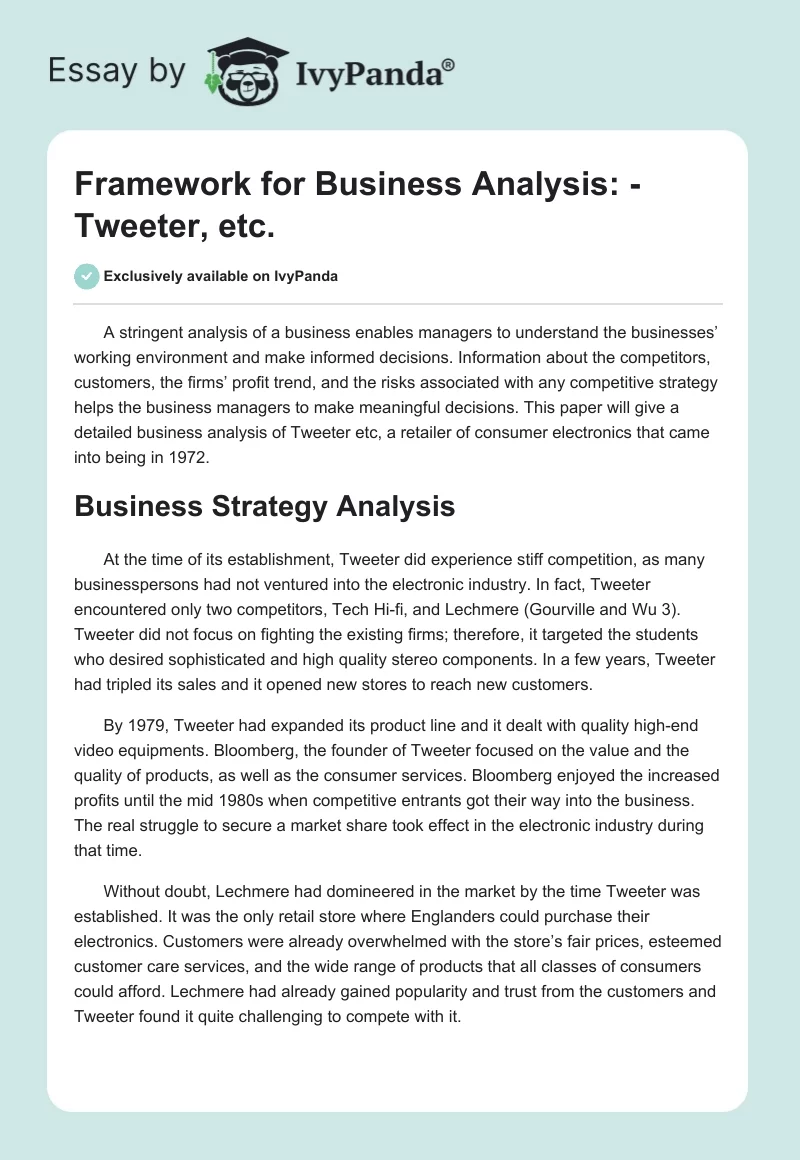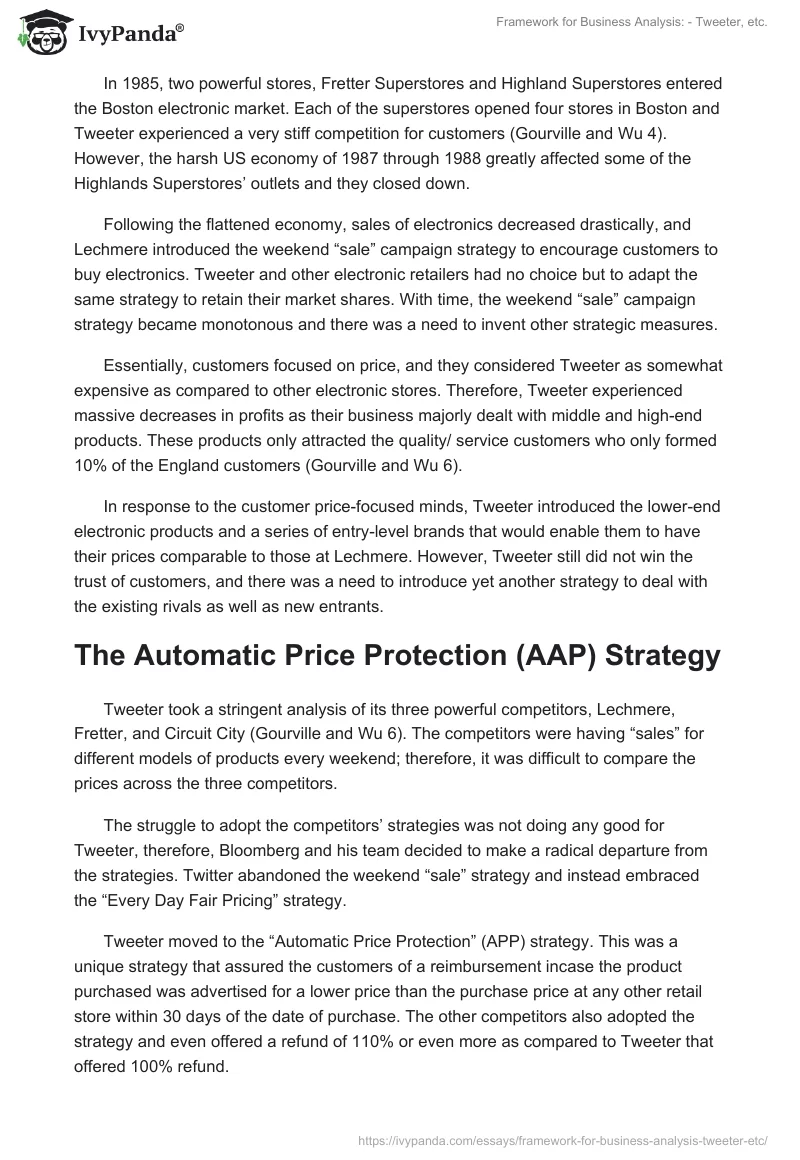A stringent analysis of a business enables managers to understand the businesses’ working environment and make informed decisions. Information about the competitors, customers, the firms’ profit trend, and the risks associated with any competitive strategy helps the business managers to make meaningful decisions. This paper will give a detailed business analysis of Tweeter etc, a retailer of consumer electronics that came into being in 1972.
Business Strategy Analysis
At the time of its establishment, Tweeter did experience stiff competition, as many businesspersons had not ventured into the electronic industry. In fact, Tweeter encountered only two competitors, Tech Hi-fi, and Lechmere (Gourville and Wu 3). Tweeter did not focus on fighting the existing firms; therefore, it targeted the students who desired sophisticated and high quality stereo components. In a few years, Tweeter had tripled its sales and it opened new stores to reach new customers.
By 1979, Tweeter had expanded its product line and it dealt with quality high-end video equipments. Bloomberg, the founder of Tweeter focused on the value and the quality of products, as well as the consumer services. Bloomberg enjoyed the increased profits until the mid 1980s when competitive entrants got their way into the business. The real struggle to secure a market share took effect in the electronic industry during that time.
Without doubt, Lechmere had domineered in the market by the time Tweeter was established. It was the only retail store where Englanders could purchase their electronics. Customers were already overwhelmed with the store’s fair prices, esteemed customer care services, and the wide range of products that all classes of consumers could afford. Lechmere had already gained popularity and trust from the customers and Tweeter found it quite challenging to compete with it.
In 1985, two powerful stores, Fretter Superstores and Highland Superstores entered the Boston electronic market. Each of the superstores opened four stores in Boston and Tweeter experienced a very stiff competition for customers (Gourville and Wu 4). However, the harsh US economy of 1987 through 1988 greatly affected some of the Highlands Superstores’ outlets and they closed down.
Following the flattened economy, sales of electronics decreased drastically, and Lechmere introduced the weekend “sale” campaign strategy to encourage customers to buy electronics. Tweeter and other electronic retailers had no choice but to adapt the same strategy to retain their market shares. With time, the weekend “sale” campaign strategy became monotonous and there was a need to invent other strategic measures.
Essentially, customers focused on price, and they considered Tweeter as somewhat expensive as compared to other electronic stores. Therefore, Tweeter experienced massive decreases in profits as their business majorly dealt with middle and high-end products. These products only attracted the quality/ service customers who only formed 10% of the England customers (Gourville and Wu 6).
In response to the customer price-focused minds, Tweeter introduced the lower-end electronic products and a series of entry-level brands that would enable them to have their prices comparable to those at Lechmere. However, Tweeter still did not win the trust of customers, and there was a need to introduce yet another strategy to deal with the existing rivals as well as new entrants.
The Automatic Price Protection (AAP) Strategy
Tweeter took a stringent analysis of its three powerful competitors, Lechmere, Fretter, and Circuit City (Gourville and Wu 6). The competitors were having “sales” for different models of products every weekend; therefore, it was difficult to compare the prices across the three competitors.
The struggle to adopt the competitors’ strategies was not doing any good for Tweeter, therefore, Bloomberg and his team decided to make a radical departure from the strategies. Twitter abandoned the weekend “sale” strategy and instead embraced the “Every Day Fair Pricing” strategy.
Tweeter moved to the “Automatic Price Protection” (APP) strategy. This was a unique strategy that assured the customers of a reimbursement incase the product purchased was advertised for a lower price than the purchase price at any other retail store within 30 days of the date of purchase. The other competitors also adopted the strategy and even offered a refund of 110% or even more as compared to Tweeter that offered 100% refund.
The struggle continued and Twitter took yet another step of tracking the newspapers and other advertisement sites. Tweeter would automatically mail checks to the customers in case an advert showed a difference in pricing for items worth more than $50. Tweeter went ahead and extended their protection policy to 60 days, and this changed the strategy to a “Regular Price Protection” strategy.
In addition to the regular price protection strategy, Tweeter invested in television advertisement, radio advertisements, creation of product catalogues as well as mailing seasonal “buyer’s guide” to individuals who had made purchases at Tweeter for the past one and a half years.
Conclusion
Indeed, the above-mentioned strategies, and especially APP, enabled Tweeter to double its sales. APP is a strategy that sought to acquire new customers and maintain the existing ones. However, in the 1995 consumer survey data, it is evident that 77% of the respondents were not aware of the APP, and it is upon Tweeter to popularize its strategy (Gourville and Wu 24).
By concentrating on the middle and high-end products, Tweeter focuses on the quality/ service customers. This fact has made customers to have the perception that Tweeter’s prices are high as compared to its customers. Therefore, Twitter should keep up with the APP, popularize it, and introduce the entry-level brands to win the entry-level customers and change the customer’s perceptions about its prices.
Work Cited
Gourville, John, and George Wu. Tweeter Etc., Boston, MA: Harvard Business School Publishing, 1996. Print.


